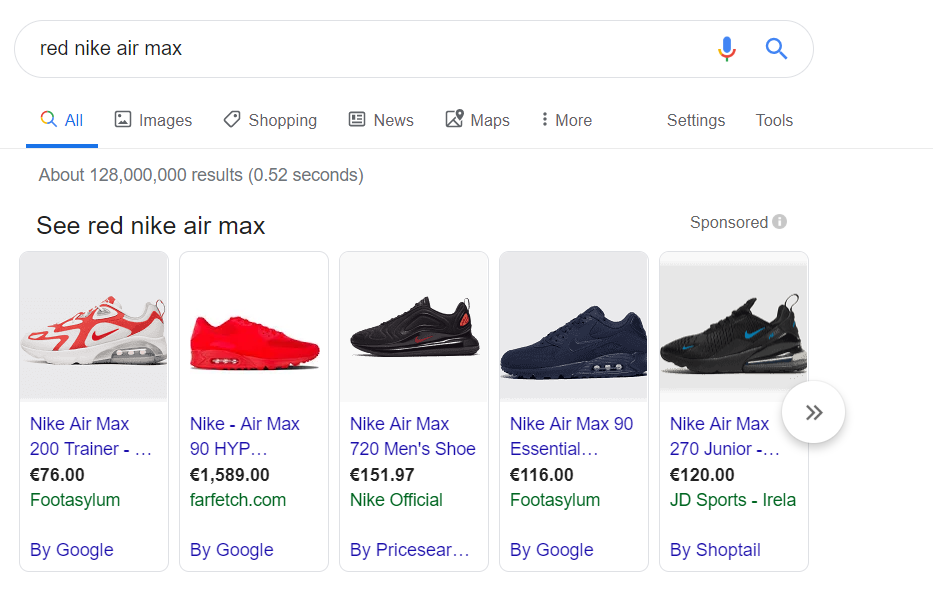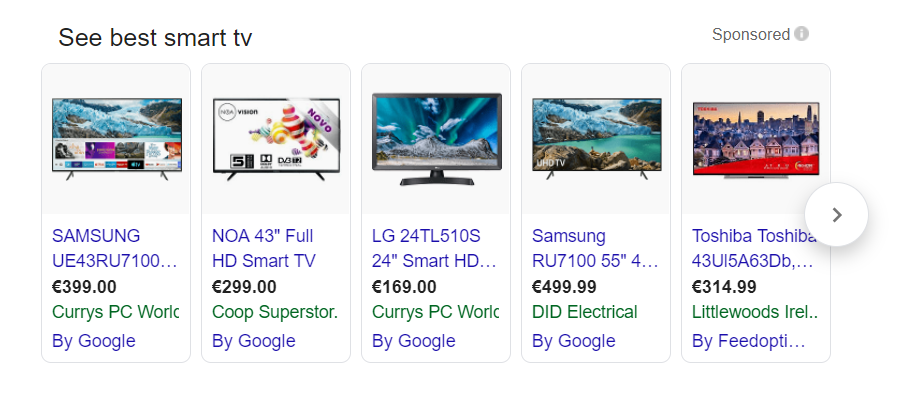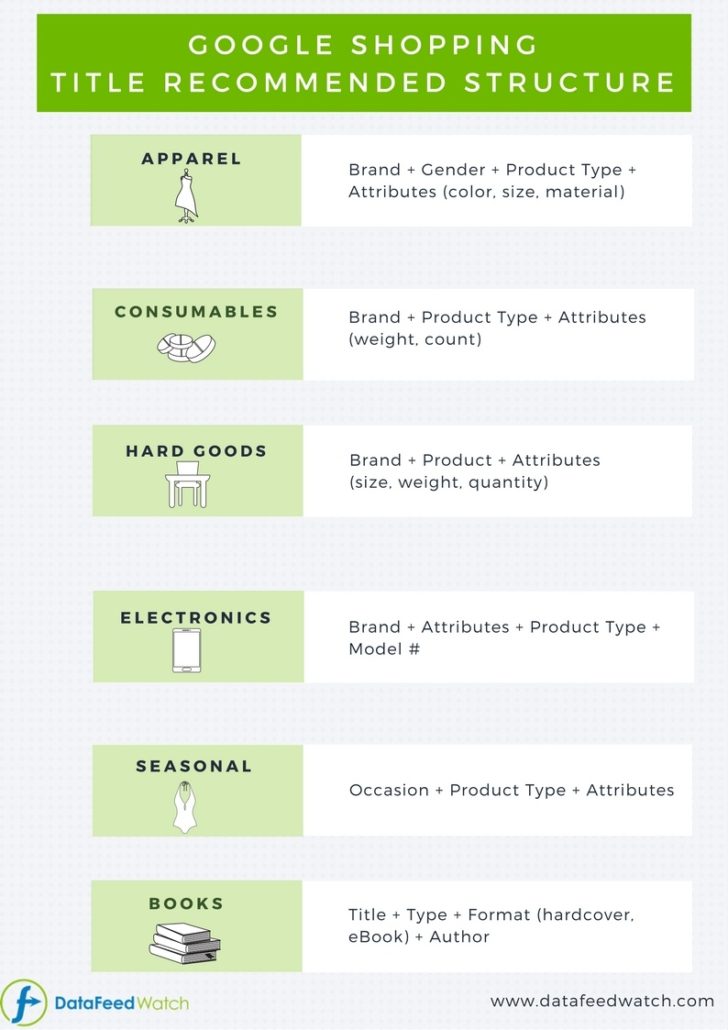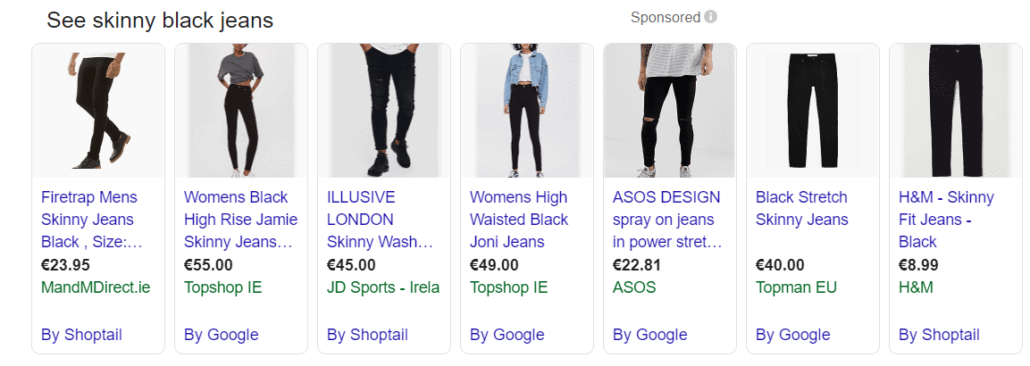It’s the festive season, and for eCommerce businesses, that means one thing; It’s “Go!” time.
Google Shopping has proven itself to be invaluable to retailers. According to a Smart Insights, Google Shopping ads (also referred to as Product Listing Ads) now account for 76.4% of all retail search ad spend, and are responsible for over 85% of all search ad clicks in the retail sector. They are powerful statistics. So, whether you’re selling Christmas jumpers or car parts, it is crucial that you optimise your Google Shopping feed and campaigns to give yourself the best chance of converting high-intent traffic. Here’s our Top 5 Tips to get your Google Shopping feed optimised for this holiday season.
1. The GTIN (Global Trade Item Number)
Though this is not required for every product (eg. multi-packs of items, custom products, antiques etc.), the GTIN is key to the optimisation process. Why?
When a customer is looking for a product (eg. Nike Air Max runners), Google uses the GTIN from the supplier’s catalogue (Nike), and puts your ad into an auction with other resellers. From there, Google will pick up on the product attributes defined in the supplier’s catalogue and will override any changes or optimisations made in your feed.

The GTIN can also help you rank in searches that contain words like “top”, “best”, “most popular” etc. Google uses the GTIN to identify which products have the best and most reviews (and generally relies on third party review sites like TrustPilot), and uses these to rank the products.

2. Product Titles
This might seem obvious, but product titles are key to success with Google Shopping. When you are building out your products to upload them to your feed and/or website, we would recommend tackling the product titles last.
The reasoning for this is that, if you have all the other product attributes optimised first, you will then have a clearer idea of what features should be mentioned in the title. However, it also depends on what product vertical you are in. As the below infographic from datafeedwatch.com shows, you should structure your title in certain ways depending on your product type.

It is wise to ensure that important keywords are included. Compile a search term report to see which queries have converted and try to use them in your titles.
PRO TIP: If you really want to hone in on what keywords are the most effective for your store, conduct some keyword tests in your feed. Also, you should be mirroring product information from the website, so when users click the ad, they will find the same information on the site.
3. Accurate Colour Attributes
It used to be best practice to simplify the colors of your products to something a user would be more likely to search for.
As an example, if a tshirt was labelled “pomegranate”, you might have changed this to “red”. However, now your ads will be disapproved for mismatching landing page information. Google crawls the micro data on landing pages and will match the colour attribute in the feed to the colour value on the landing page.
4. Enable Dynamic Re-Pricing
Competitive pricing is vital to your eCommerce strategy.
There are dynamic solutions to help keep up with the price fluctuations in the shopping space. If you are using a third party solution like Wisepricer, you will be able to use their tool to run daily price checks to see how your pricing is compared to your competitors.
If you want to use a feed optimisation platform, you can label your products according to their price. For example, you could use labels such as “high” “medium” and low, depending on the price of the product. Then, in Google Ads, you will be able to up your bids on products that are competitively priced, and reduce your bid on those products that are higher in price and thus, less competitive.
Be careful when using this strategy however, as it is not ideal for all product verticals. Also be aware that if you convert a customer on one day and the next day, they see the same product on your site for a lower cost, they will not be happy.
5. Product Images
Images are absolutely crucial to your Google Shopping feed. When a potential customer searches for a product, their first thing they see is the image.
Here are some key points to for making sure your image link is optimized:
- Use high resolution pictures
- Make sure the variants match the picture (colour, size, material etc.)
- Look out for text over the picture (watermarks, sales, manufacture parts numbers)
- Test product images vs lifestyle images, as below (to find which works best for your brand)

Are you considering Google Shopping for your business, but don’t know where to start? Call or email us today and let WebResults help you get your Google Shopping feed and campaigns up and running in no time.
PPC trends – 4 things to expect in 2020
adwords, digital marketing, google, google + for business, Google Adwords, Google AdWords Management, google update, internet marketing, Online Marketing, Pay Per Click, PPC, PPC Tips, web marketing managementAs you are probably aware, Google love to keep us on our toes! It is important to keep on top of these changes in order to make sure you are getting maximum from Google. Here are 4 trends that we believe will become more prominent in 2020.
Having computers do the work for you sounds great, doesn’t it? While this may be true to some degree, PPC advertisers need to be careful about how far they go with this. This will be the year that we need to meet AI head on and use it to drive ourselves forward. If not, your business could fall behind and end up playing catch-up.
Google Ads has been encouraging advertisers to let them take the reigns on their campaigns. This is helpful to a certain degree. What you have to remember is that Google want as many clicks as possible, because at the end of the day, it’s how they make their money. So, what we advise is to not give them complete control. Create your own Google Ads custom rules to optimise bids, budgets, marketing lists, etc. and that way, you can use automation to ensure you get the best value for money.
Starting in December of last year, Google Ads have expanded their optimisation score to include Display campaigns, as well as Search and Shopping campaigns. It works in the exact same way as previously with scores ranging from 0% to 100%. An optimisation score of 100% means your campaign is running to its full potential.
This change ties into the increased volume automation in Google Ads and, as said before, it can be incredibly helpful for advertisers but only when used correctly. Don’t get sucked into thinking everything Google recommends is for your benefit. Remember, Google wants to make money too.
Audience targeting or segmenting refers to the ability to choose who exactly sees your ads depending on their location, age, sex, buying habits, clicking habits and a whole range of other factors. With the help of ever-improving AI, Google Ads is making this a lot more efficient and therefore, they have made it a lot easier for PPC advertisers to target exactly who they want.
In 2020, Google Ads will continue to grow their machine learning which will help us create highly personalised ad campaigns and improve your target market strategies.
One negative trend that we expect to see for 2020 is an increase in CPC. Google has 5.6 billion searches per day, and this number is only growing. Thus, using Google Ads as your main marketing tool is essential. SERPs (Search Engine Results Pages) are becoming more competitive and organic searches becoming harder to find. This means that big corporations will simply increase their spending on keywords and therefore, drive up the average CPC for everyone else.
Google’s forever changing trends can be a bit daunting to get your head around. If you find yourself stuck, confused or overwhelemd, maybe it’s time to think about outsourcing to an agency. If you choose the right one, we guarantee you will see an increase in productivity and ultimately an increase in ROI.
If you are interested in talking to WebResults about your Google Ads account, call or email us today for a free account review and find out what we can do for you.
All getting a bit too much? Here are 3 reasons why you should consider outsourcing your Google Ads management.
adwords, digital marketing, Google Adwords, Google AdWords Management, internet marketing, Online Marketing, Pay Per Click, PPC, PPC Tips, Web Marketing, web marketing managementManaging your Google Ads takes time and dedication. As you grow, this workload is only going to get bigger and bigger. So, maybe it’s time to outsource it to a dedicated Google Ads company such as WebResults. Here are some things to keep an eye on if you want to maximise your ROI.
As I just said managing your Google Ads takes up a lot of time and effort. As your business grows you may be finding yourself dedicating too much time to your Google Ads management. Advertising online is essential but running a business involves so much more than just that. Outsourcing the maintenance and management of your PPC management could free up essential time you could be dedicating to getting new clients and therefore growing your business.
While you may think the resolution to your problem is just hiring a new in-house marketing manager, it might not be the right fit. Sit back and evaluate it. You hire one new marketing manager, pay them a salary, benefits etc. You may have to train them in on your systems and they may have to get up-to-date with Google Ads. If you outsource this to an agency, they will have multiple people working on your account, they already know their systems and they are already Google Ads experts. This is something you will have to take some time to calculate but more often than not it can work out costing the same amount and again it will free up your precious time.
In reality most SMEs are outsourcing their digital marketing management. Keeping on top of all the constantly changing trends and strategies is what will keep you ahead of the competition. Specialised agencies will always be on top of these ever-changing trends and therefore should keep you competitive. At the end of the day, they are experts.
So, whether you’re finding yourself using up too much precious time, spending too much or falling behind your competitors, you really need to take a step back and think “should I just get an agency?” If you choose the right one,we guarantee you will see an increase in productivity and ultimately an increase in ROI.
If you are interested in talking to us about your Google Ads account, call or email us today for a free account review and find out what we can do for you.
Top 5 Tips To Optimise Your Google Shopping Feed
shoppingIt’s the festive season, and for eCommerce businesses, that means one thing; It’s “Go!” time.
Google Shopping has proven itself to be invaluable to retailers. According to a Smart Insights, Google Shopping ads (also referred to as Product Listing Ads) now account for 76.4% of all retail search ad spend, and are responsible for over 85% of all search ad clicks in the retail sector. They are powerful statistics. So, whether you’re selling Christmas jumpers or car parts, it is crucial that you optimise your Google Shopping feed and campaigns to give yourself the best chance of converting high-intent traffic. Here’s our Top 5 Tips to get your Google Shopping feed optimised for this holiday season.
1. The GTIN (Global Trade Item Number)
Though this is not required for every product (eg. multi-packs of items, custom products, antiques etc.), the GTIN is key to the optimisation process. Why?
When a customer is looking for a product (eg. Nike Air Max runners), Google uses the GTIN from the supplier’s catalogue (Nike), and puts your ad into an auction with other resellers. From there, Google will pick up on the product attributes defined in the supplier’s catalogue and will override any changes or optimisations made in your feed.
The GTIN can also help you rank in searches that contain words like “top”, “best”, “most popular” etc. Google uses the GTIN to identify which products have the best and most reviews (and generally relies on third party review sites like TrustPilot), and uses these to rank the products.
2. Product Titles
This might seem obvious, but product titles are key to success with Google Shopping. When you are building out your products to upload them to your feed and/or website, we would recommend tackling the product titles last.
The reasoning for this is that, if you have all the other product attributes optimised first, you will then have a clearer idea of what features should be mentioned in the title. However, it also depends on what product vertical you are in. As the below infographic from datafeedwatch.com shows, you should structure your title in certain ways depending on your product type.
It is wise to ensure that important keywords are included. Compile a search term report to see which queries have converted and try to use them in your titles.
PRO TIP: If you really want to hone in on what keywords are the most effective for your store, conduct some keyword tests in your feed. Also, you should be mirroring product information from the website, so when users click the ad, they will find the same information on the site.
3. Accurate Colour Attributes
It used to be best practice to simplify the colors of your products to something a user would be more likely to search for.
As an example, if a tshirt was labelled “pomegranate”, you might have changed this to “red”. However, now your ads will be disapproved for mismatching landing page information. Google crawls the micro data on landing pages and will match the colour attribute in the feed to the colour value on the landing page.
4. Enable Dynamic Re-Pricing
Competitive pricing is vital to your eCommerce strategy.
There are dynamic solutions to help keep up with the price fluctuations in the shopping space. If you are using a third party solution like Wisepricer, you will be able to use their tool to run daily price checks to see how your pricing is compared to your competitors.
If you want to use a feed optimisation platform, you can label your products according to their price. For example, you could use labels such as “high” “medium” and low, depending on the price of the product. Then, in Google Ads, you will be able to up your bids on products that are competitively priced, and reduce your bid on those products that are higher in price and thus, less competitive.
Be careful when using this strategy however, as it is not ideal for all product verticals. Also be aware that if you convert a customer on one day and the next day, they see the same product on your site for a lower cost, they will not be happy.
5. Product Images
Images are absolutely crucial to your Google Shopping feed. When a potential customer searches for a product, their first thing they see is the image.
Here are some key points to for making sure your image link is optimized:
Are you considering Google Shopping for your business, but don’t know where to start? Call or email us today and let WebResults help you get your Google Shopping feed and campaigns up and running in no time.
How Do SEO And SEM Work Together?
advice, adwords, digital marketing, Ecommerce, google, Google Adwords, Google AdWords Management, internet marketing, Keywords, Pay Per Click, Search Engine Optimisation, search engine optimization, SEOWe are often asked by clients, “If I am already paying for ads, why should I bother with SEO?”. It’s a fair question, as is the reverse; If you are ranking very strongly in organic search results, is it really worth paying for Ads?
However, investing in both SEO and PPC advertising (also known as SEM) simultaneously can dramatically increase your business’ revenue, traffic and conversions.
First of all, it is important to highlight the differences between organic search (SEO) and paid search (SEM/PPC).
SEO/Organic Search:
Search Engine Optimisation is all about the long-term health of your digital presence and strategy. If you follow SEO best practices, your site is more likely to appear in organic (unpaid) searches.
SEO is the foundation of good SEM (Search Engine Marketing) and when you have them harmonising perfectly, you will drive high-quality traffic and leads as well as improve your site’s conversion rates. SEO incorporates everything from using keywords throughout your site to the User Experience and performance of your site on mobile.
Once you have an SEO-friendly site and sponsored ads that are using the right keywords, you have a better chance of showing up at the top of paid searches. But you need to have your SEO in place in order for Google to see you as a credible website.
SEM/Paid Search:
One of the biggest strengths of SEM is that it can deliver success and growth quickly. If your website/business is reasonably new, you can prioritise your paid search efforts first, as it can take a while for SEO rankings to become established. However, do not ignore your SEO during this process. Think of SEM as a platform to launch your search efforts, and SEO as a way of maintaining a strong and healthy digital presence.
It is important to note that having PPC ads running does not do anything for your site’s SEO. However, by improving your SEO, you can make your PPC costs more efficient.
How Do SEO And SEM Work Together?
In very simple terms, if your organic rankings are strong and your paid efforts are optimised, you will dominate Google’s SERP (Search Engine Results Page).
For example, if your business sells hammers as its main product, prioritise hammers (and associated terms such as “claw hammers”, “mallets” etc.) in your keyword strategy, both in an organic and paid context. What that means is, make sure your site pages are built with your priority keywords in mind. This includes everything from your page content to your alt, image and meta tags, captions, URLs, etc. This will improve your organic search results.
But what’s the point in appearing twice on a search engine page?
Paid search ads help you recover any missed opportunities. A study by Google found that when search ads for a keyword were paused, approximately 89% of traffic generated by these ads were not replaced by the organic rankings. That means that, even if your site is ticking all of the SEO boxes in terms of keywords, it’s very possible that you will be missing valuable traffic and thus, potential customers.
By relying on PPC, you’re recovering clicks and interest from searchers that you might have otherwise missed. Even if you aren’t ranking #1 naturally, PPC can help you draw in traffic from those looking for your products or services, often at a small cost.
Remember, by the time a person is conducting a search on a product, they have more than likely reached the “intent” stage and are asking to be converted. That is why search marketing is so important and so valuable.
Conclusion
While SEM can help deliver fast results, SEO is imperative to building and maintaining a successful digital marketing strategy for your business.
By following SEO best practices, you will not only enhance your chances of ranking organically in search engine results (thus driving free clicks to your site), but it will also lend your site credibility in the eyes of Google (which is the primary search engine used by approximately 81% of the entire web population). This means you will see higher levels of valuable traffic on your site and thus, bring your business to the next level.
Are you interested in Google Ads, SEM or SEO services? Contact us today at info@webresults.ie and talk to our team.
GDPR and Email Marketing (Storing Email Contacts & Communication)
adwords, Pay Per ClickMake Your Website GDPR Compliant
adwords, Pay Per Click6 Ways To Dramatically Improve Your ROI from Google AdWords in 2018
adwords, Pay Per ClickThe Importance Of Optimised Landing Pages For AdWords Campaigns
Pay Per ClickThere is no doubt that having an appealing website that is easy to navigate around can play a role in increasing conversions. Similarly by making it as easy as possible for visitors to reach the information they are looking for will also contribute to high conversions.
Special Offer – Sign up For Adwords Management Today and Get 1 Month Free Management
adwordsWhy it makes more business sense to outsource your Google AdWords management to a Digital Marketing agency
adwords